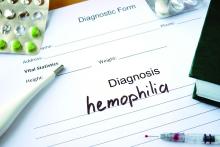First-in-human results suggest a gene therapy, BAY 2599023, can increase factor VIII levels in patients with hemophilia A, but it isn’t clear if BAY 2599023 can eliminate the need for prophylaxis.
Of four patients who received BAY 2599023, three achieved clinically meaningful factor VIII levels, and all were able to stop prophylaxis at some point. However, one patient had to resume prophylaxis, and all four have experienced bleeds since receiving BAY 2599023.
This is a dose-escalating trial (NCT03588299), so researchers are still attempting to determine the optimal dose of BAY 2599023. Upcoming results in two patients treated at the highest dose should provide more insight, according to Steven W. Pipe, MD, of the University of Michigan in Ann Arbor.
Dr. Pipe presented results with BAY 2599023 at the annual congress of the European Association for Haemophilia and Allied Disorders.
He noted that between 30% and 70% of hemophilia patients may have preexisting neutralizing antibodies to specific adeno-associated virus (AAV) serotypes. Developing gene therapies with varying serotypes could reduce this problem and increase eligibility for gene therapy. Bayer had this in mind when developing BAY 2599023.
BAY 2599023 is a non-replicating AAV vector, based on the AAV serotype hu37, which contains a single-stranded DNA genome encoding a B-domain deleted factor VIII, under the control of a liver-specific promotor/enhancer combination optimized for transgenic expression, Dr. Pipe explained.
He presented results with BAY 2599023 in four patients with severe hemophilia A. At baseline, patients were receiving prophylaxis and did not have factor VIII inhibitors or detectable immunity to the AAVhu37 capsid.
First cohort
Two patients received BAY 2599023 at a dose of 0.5 × 1013 GC/kg. One patient achieved a factor VIII level above 5% at this dose and was able to stop prophylaxis temporarily. The patient experienced two bleeds on study and had to resume prophylaxis because of a target joint.
“He came into the study with a particularly challenging target joint in his ankle, and he had known from experience on prophylaxis that, if his factor level got too low, he would have breakthrough bleeds,” Dr. Pipe explained. “So we agreed that if he didn’t achieve a sustained level above 5%, he would go back on prophylaxis. He was able to stay off prophylaxis for 6 weeks, but we had to put him back on because of breakthrough bleeding.”
Dr. Pipe and colleagues have been following this patient for about a year, and the patient still has factor VIII levels of about 2% to 3% after a washout of prophylaxis.
The other patient who received a dose of 0.5 × 1013 GC/kg came off prophylaxis early on and has sustained factor VIII levels of 20%. This patient had four bleeds early in the trial but has since done very well, Dr. Pipe said. The patient had 99 bleeds in the year prior to receiving BAY 2599023.
Second cohort
Two subsequent patients received BAY 2599023 at a dose of 1 × 1013 GC/kg. Both patients have stopped prophylaxis.
One patient achieved factor VIII levels in the 5%-10% range and stopped prophylaxis at day 49. The patient has received on-demand treatment for four bleeds. The other patient achieved “robust” factor VIII expression levels “well above 20%,” according to Dr. Pipe. This patient stopped prophylaxis at day 10 and experienced bleeds early on but has remained bleed-free and treatment-free for 7 months.
Dr. Pipe noted that this patient experienced a spike in transaminases “very early on” after receiving BAY 2599023.
“So he was put on prednisone, but his liver enzymes almost immediately corrected to within the normal range,” Dr. Pipe said. “He has finished the cascading dose of prednisone, his liver enzymes have remained stable, his factor VIII expression has remained stable, and he continues to do very well.”
Next steps
Based on results in the first two cohorts, researchers are proceeding with a higher dose of BAY 2599023.
“The overall goal of this study is to identify the optimal dose that can be taken forward to the planned phase 3 study,” Dr. Pipe said. “What they [Bayer] would like to bring to the community is a product that offers a chance for maximum eligibility based on low screen out because of preexisting immunity and maximize the number of patients who are in the normal range.”
“For patients to embrace gene therapy, it really has to get them at least the possibility to land within the normal range and, hopefully, be not just liberated from prophylaxis but maybe liberated from the need for factor VIII at all,” Dr. Pipe added. “I think if these AAV platform therapies can’t deliver that on a relatively consistent basis, it’s going to be challenging to get patients to embrace this technology.”
The phase 1/2 trial is sponsored by Bayer in collaboration with Ultragenyx Pharmaceutical Inc. Dr. Pipe disclosed relationships with Bayer and other companies.
SOURCE: Pipe SW et al. EAHAD 2020. Abstract P190.


